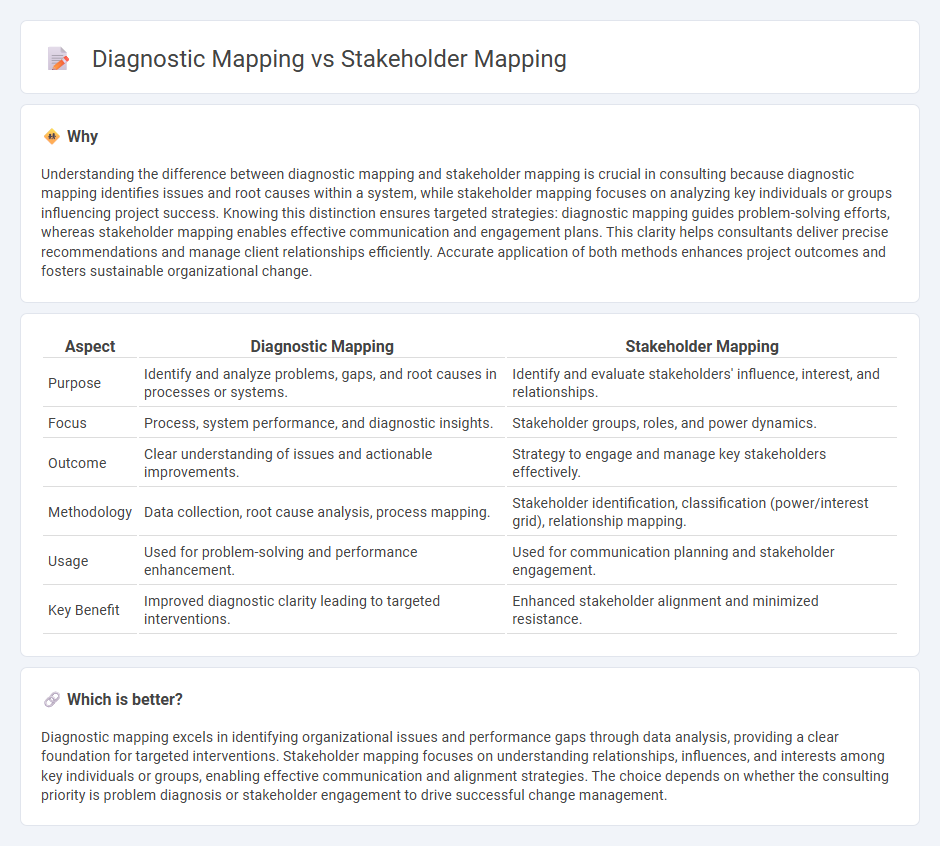
Diagnostic mapping identifies organizational challenges and inefficiencies by analyzing internal processes and workflows, providing a data-driven foundation for targeted improvements. Stakeholder mapping focuses on understanding the interests, influence, and relationships of key individuals and groups impacted by or involved in a project, ensuring effective communication and engagement. Explore the differences between these two essential consulting tools to optimize your strategic planning and execution.
Why it is important
Understanding the difference between diagnostic mapping and stakeholder mapping is crucial in consulting because diagnostic mapping identifies issues and root causes within a system, while stakeholder mapping focuses on analyzing key individuals or groups influencing project success. Knowing this distinction ensures targeted strategies: diagnostic mapping guides problem-solving efforts, whereas stakeholder mapping enables effective communication and engagement plans. This clarity helps consultants deliver precise recommendations and manage client relationships efficiently. Accurate application of both methods enhances project outcomes and fosters sustainable organizational change.
Comparison Table
| Aspect | Diagnostic Mapping | Stakeholder Mapping |
|---|---|---|
| Purpose | Identify and analyze problems, gaps, and root causes in processes or systems. | Identify and evaluate stakeholders' influence, interest, and relationships. |
| Focus | Process, system performance, and diagnostic insights. | Stakeholder groups, roles, and power dynamics. |
| Outcome | Clear understanding of issues and actionable improvements. | Strategy to engage and manage key stakeholders effectively. |
| Methodology | Data collection, root cause analysis, process mapping. | Stakeholder identification, classification (power/interest grid), relationship mapping. |
| Usage | Used for problem-solving and performance enhancement. | Used for communication planning and stakeholder engagement. |
| Key Benefit | Improved diagnostic clarity leading to targeted interventions. | Enhanced stakeholder alignment and minimized resistance. |
Which is better?
Diagnostic mapping excels in identifying organizational issues and performance gaps through data analysis, providing a clear foundation for targeted interventions. Stakeholder mapping focuses on understanding relationships, influences, and interests among key individuals or groups, enabling effective communication and alignment strategies. The choice depends on whether the consulting priority is problem diagnosis or stakeholder engagement to drive successful change management.
Connection
Diagnostic mapping identifies core organizational issues by analyzing processes and performance metrics, creating a foundation for targeted interventions. Stakeholder mapping builds on this by pinpointing key individuals and groups affected by or influencing these issues, facilitating effective communication and engagement. Together, they enable consultants to design strategic solutions aligned with organizational dynamics and stakeholder interests.
Key Terms
**Stakeholder Mapping:**
Stakeholder mapping systematically identifies and categorizes individuals or groups based on their influence, interest, and impact on a project or organization, enabling targeted engagement strategies. It is essential for aligning resources and communication efforts to enhance collaboration and decision-making effectiveness. Explore detailed methods and applications of stakeholder mapping to optimize your project's success.
Influence
Stakeholder mapping identifies and categorizes individuals or groups based on their level of influence and interest in a project, enabling targeted engagement strategies. Diagnostic mapping goes deeper by analyzing the power dynamics and relationships between stakeholders to uncover underlying influences affecting decision-making. Discover more about how influence shapes strategic planning through advanced mapping techniques.
Interest
Stakeholder mapping prioritizes identifying and categorizing individuals or groups based on their interest and influence in a project, helping to tailor engagement strategies effectively. Diagnostic mapping goes deeper by analyzing stakeholders' motivations, concerns, and potential impact to diagnose underlying issues affecting project success. Discover how these mapping techniques enhance strategic decision-making and stakeholder management.
Source and External Links
What is Stakeholder Mapping? Techniques and Steps - SixSigma.us - Stakeholder mapping is a strategic tool used to visualize and analyze relationships between project parties, involving a five-step process: identifying stakeholders, analyzing their characteristics, prioritizing key stakeholders, and developing engagement strategies for better outcomes.
Stakeholder Mapping: Guide to Identifying & Engaging Key ... - Stakeholder mapping identifies and categorizes all individuals or groups impacted by or impacting a project through a plan-engage-measure methodology, focusing on tailored communication strategies for each category.
How to create a stakeholder map [templates & examples] - Mural - A stakeholder map visually represents stakeholders' interest and influence through grid systems or network diagrams to help understand relationships and guide stakeholder engagement and communication.
 dowidth.com
dowidth.com